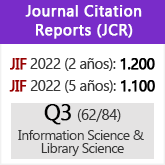Evaluación de la transferencia de conocimiento e innovación de las universidades españolas
DOI:
https://doi.org/10.3989/redc.2019.3.1596Palabras clave:
transferencia de conocimiento, evaluación de la innovación, rankings internacionales de universidades, transferencia de tecnología, triple hélice, análisis de redes sociales, evaluación de la investigaciónResumen
La estrategia europea Horizon 2020 se centra en la transición hacia la sociedad del conocimiento. Con este objetivo, la Comisión Europea ha elegido a las universidades por su capacidad para conectar y colaborar con otros sectores, particularmente el empresarial. Si bien sus esfuerzos se han dirigido a crear sinergias entre los sectores implicados, se ha obviado su evaluación. El estudio que se presenta utiliza metadatos de SCOPUS y de la Oficina Española de Patentes. Se pretende evaluar la transferencia de conocimiento desde la perspectiva de la universidad. Para ello, se emplean las colaboraciones de las universidades con otras universidades, con empresas y con instituciones gubernamentales. La evaluación se hace conjuntamente a partir de la red que las universidades españolas generan en su conjunto. Los resultados obtenidos muestran el grado de conectividad de cada universidad, su grado de influencia y su conectividad con instituciones líderes en innovación y transferencia de conocimiento.
Descargas
Citas
Academic Ranking of World Universities (2015). Methodology. Disponible en: http://www. shanghairanking.com/ARWU-Methodology-2014.html [Fecha de consulta: 05/05/2015]
Bathelt, H.; Malmberg, A.; Maskell, P. (2004). Clusters and knowledge: local buzz, global pipelines and the process of knowledge creation. Progress in Human Geography, 28(1), 31-56. https://doi.org/10.1191/0309132504ph469oa
Boulton, G. (2011). University Rankings: Diversity, Excellence, and the European Initiative. Procedia Social and Behavioral Sciences, 13, 74-82. https://doi.org/10.1016/j.sbspro.2011.03.006
Brandes, U. (2001). A faster algorithm for betweenness centrality. Journal of Mathematical Sociology, 25, 163- 177. https://doi.org/10.1080/0022250X.2001.9990249
Brems, B.; Button, K.; Munafo, M. (2013). Deep impact: unintended consequences of journal rank. Frontiers in Human Neuroscience, 7. https://doi.org/10.3389/fnhum.2013.00291 PMid:23805088 PMCid:PMC3690355
Chang, F. P.-C.; Ouyang, L.-Y. (2018). Trend models on the academic ranking of world universities. International Journal of Information and Management Sciences, 29(1), 35-56.
Chou, C. P. ; Lin, H. F. ; Chiu, Y. (2013). The impact of SSCI and SCI on Taiwan's academy: an outcry for fair play. Asia Pacific Education Review, 14(1), 23-31. https://doi.org/10.1007/s12564-013-9245-1
Choudhri, A. F.; Siddiqui, A.; Khan, N. R.; Cohen, H. L. (2015). Understanding bibliometric parameters and analysis. Radiographics, 35(3), 736-746. https://doi.org/10.1148/rg.2015140036 PMid:25969932
Daraio, C. (2008). Current developments in Third Mission indicator development: the needs from academia. Workshop Third Mission Approaches and Indicators: The way forward, Valencia, Spain. Disponible en: http://www.ingenio.upv.es/sites/default/files/ otros_seminarios/dar_pres.pdf [Fecha de consulta: 22/06/2016]
European Commission, (2011). Supporting growth and jobs - an agenda for the modernization of Europe's higher education systems. Communication from the Commission to the European Parliament, the Council, the European Economic and Social Committee and the Committee of the Regions {SEC(2011) 1063 final}. Disponible en: http://eur-lex.europa.eu/LexUriServ/ LexUriServ.do?uri=COM:2011:0567:FIN:EN:PDF [Fecha de consulta: 20/06/2016]
European Commission, (2014). Horizon 2020 in brief. The EU Framework Programme for Research & Innovation. Publications Office of the European Union, Luxembourg. Disponible en: https://ec.europa.eu/ programmes/horizon2020/sites/horizon2020/files/ H2020_inBrief_EN_FinalBAT.pdf [Fecha de consulta: 20/06/2016]
Florian, R. V. (2007). Irreproducibility of the results of the Shanghai Academic Ranking of World Universities. Scientometrics, 72(1), 25-32. https://doi.org/10.1007/s11192-007-1712-1
Freeman, L. C. (1979). Centrality in social networks conceptual clarification. Social Networks, 1(3), 215-239. https://doi.org/10.1016/0378-8733(78)90021-7
Johnes, J. (2018). University rankings: What do they really show? Scientometrics, 115(1), 585-606. https://doi.org/10.1007/s11192-018-2666-1
Leydesdorff, L. (2012). The triple helix, quadruple helix, …, and N-tuple of helices Helix, Quadruple Helix,…, and an N-tuple of Helices: Explanatory models for analyzing the knowledge-base economy? Journal of the Knowledge Economy, 3(1), 25-35. https://doi.org/10.1007/s13132-011-0049-4
Leydesdorff, L. (2013). An evaluation of impacts in "Nanoscience & nanotechnology": steps towards standards for citation analysis. Scientometrics, 94(1), 35- 55. https://doi.org/10.1007/s11192-012-0750-5 PMid:23293403 PMCid:PMC3535360
Liaw, Y.-C.; Chan, T.-Y.; Fan, C.-Y.; Chiang, C.-H. (2014). Can the technological impact of academic journals be evaluated? The practice of non-patent reference (NPR) analysis. Scientometrics, 101(1), 17-37. https://doi.org/10.1007/s11192-014-1337-0
Newman, M. E. J. (n.d.). The mathematics of networks. Disponible en: http://www-personal.umich. edu/~mejn/papers/palgrave.pdf [Fecha de consulta: 20/09/2107]
Nielsen, K. (2015). Human capital and new venture performance: the industry choice and performance of academic entrepreneurs. Journal of Technology Transfer, 40(3), 453-474. https://doi.org/10.1007/s10961-014-9345-z
Pandiella-Dominique, A.; Moreno-Lorente, L.; García- Zorita, C.; Sanz-Casado, E. (2018). Model for estimating Academic Ranking of World Universities (Shanghai Ranking) scores. Revista Española de Documentación Científica, 41(2), e204. https://doi.org/10.3989/redc.2018.2.1462
Pietrucha, J. (2018). Country-specific determinants of world university rankings. Scientometrics, 114(3), 1129-1139. https://doi.org/10.1007/s11192-017-2634-1 PMid:29491546 PMCid:PMC5814474
QS Staff Writer (2015). QS World University Rankings: Methodology. Disponible en: http://www. topuniversities.com/university-rankings-articles/ world-university-rankings/qs-world-university-rankings-methodology?page=1 [Fecha de consulta: 05/05/2015]
Ranga, M.; Etzkowitz, H. (2013). Triple Helix Systems: An analytical framework for innovation policy and practice in the knowledge society. Industry and Higher Education, 27(4), 237-262. https://doi.org/10.5367/ihe.2013.0165
Rossi, F.; Rosli, A. (2015). Indicators of university-industry knowledge transfer performance and their implications for universities: evidence from the United Kingdom. Studies in Higher Education, 40(10), 1970-1991. https://doi.org/10.1080/03075079.2014.914914
Stergiou, K. I.; Lessenich, S. (2014). On impact factors and university rankings: from birth to boycott. Ethics in Science and Environmental Politics, 13(2), 101-111. https://doi.org/10.3354/esep00141
Times Higher Education World University Ranking (2015). World University Rankings 2014-2015 methodology. Disponible en: https://www.timeshighereducation. co.uk/world-university-rankings/2014-15/subject-ranking/subject/engineering-and-IT/methodology [Fecha de consulta: 05/05/2015]
U-Multirank (2015). Methodology: The Project. Disponible en: https://www.umultirank.org/about/methodology/ our-approach/ [Fecha de consulta: 08/05/2015]
Publicado
Cómo citar
Número
Sección
Licencia
Derechos de autor 2019 Consejo Superior de Investigaciones Científicas (CSIC)

Esta obra está bajo una licencia internacional Creative Commons Atribución 4.0.
© CSIC. Los originales publicados en las ediciones impresa y electrónica de esta Revista son propiedad del Consejo Superior de Investigaciones Científicas, siendo necesario citar la procedencia en cualquier reproducción parcial o total.Salvo indicación contraria, todos los contenidos de la edición electrónica se distribuyen bajo una licencia de uso y distribución “Creative Commons Reconocimiento 4.0 Internacional ” (CC BY 4.0). Puede consultar desde aquí la versión informativa y el texto legal de la licencia. Esta circunstancia ha de hacerse constar expresamente de esta forma cuando sea necesario.
No se autoriza el depósito en repositorios, páginas web personales o similares de cualquier otra versión distinta a la publicada por el editor.

















